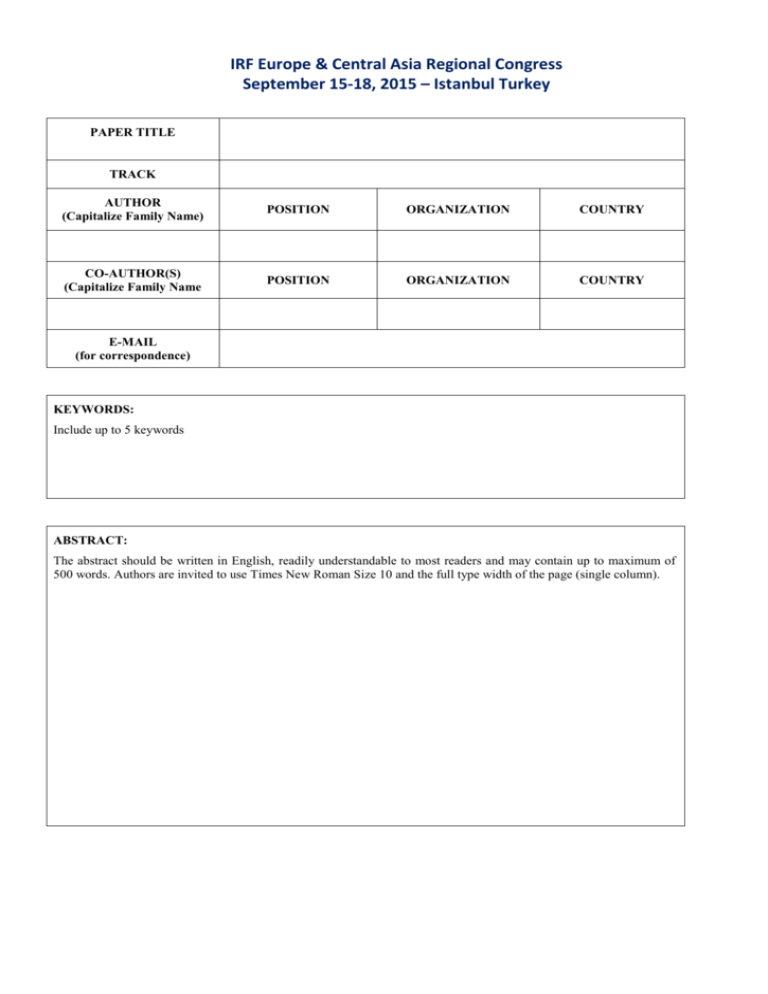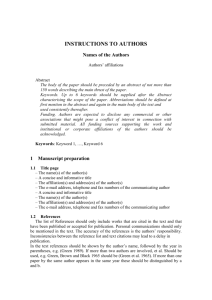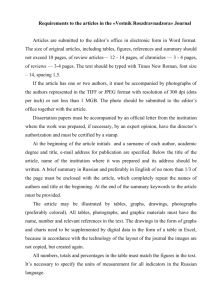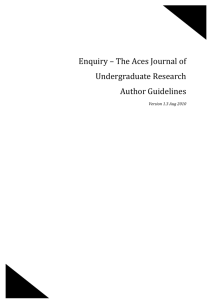4 tables and figures - International Road Federation
advertisement

IRF Europe & Central Asia Regional Congress September 15-18, 2015 – Istanbul Turkey PAPER TITLE TRACK AUTHOR (Capitalize Family Name) POSITION ORGANIZATION COUNTRY CO-AUTHOR(S) (Capitalize Family Name POSITION ORGANIZATION COUNTRY E-MAIL (for correspondence) KEYWORDS: Include up to 5 keywords ABSTRACT: The abstract should be written in English, readily understandable to most readers and may contain up to maximum of 500 words. Authors are invited to use Times New Roman Size 10 and the full type width of the page (single column). A Guide to helping authors prepare their full papers for the Europe & Central Asia Congress of the International Road Federation Dr Essam Radwan1 1The University of Central Florida, Orlando, Florida, USA Email for correspondence, e.g. info@irfnews.org 1 INTRODUCTION After receiving notification of acceptance of abstracts, authors wishing to see their work recognized in the official proceedings of the Europe & Central Asia Congress must prepare a full-length paper of total length (inclusive of all text, tables, figures and references) of not more than 8 A4 size pages. This document provides a set of instructions for preparing your paper and an example of the style you are required to use. Authors may use this document and follow the guidelines to adjust the format of their paper to the required form. The paper will be expected to be a complete treatment and presentation, with all the usual elements of a selfcontained scientific or technical paper. Contributions are accepted on the understanding that the paper is original and has not been published before. It should comply in structure and layout with the instructions given below. Papers are to be submitted electronically in Microsoft Word Document format. Please note that the submitted papers will be reviewed for scientific/technical merit and checked for compliance with preparation instructions; authors may be required to re-submit amended papers following this process. 2 DRAFTING GUIDELINES You may use any word processor as long as it can save documents in any MS Word .DOC format from Word 97 and above. Authors should follow these guidelines in writing their papers. The paper must be formatted to A4 paper size. First the paper size must be customized to 21 cm width and 29.7 cm height. Then the page set up must be adjusted to top 3 cm, bottom 3 cm, left 2.75 cm, right 2.75 cm. The body text should be aligned to “justified” style and line spacing must be single. Preferred font type is Times New Roman size 10. 3 ABBREVIATIONS AND UNITS Abbreviations should conform to normal standards. Non-standard abbreviations should be spelt in full the first time and the abbreviation given in parentheses SI (international system) units must be used throughout the whole text. 4 TABLES AND FIGURES All diagrams, charts, maps, photographs etc., are to be referred to as figures. Within the text, refer to figures by the word Figure followed by the figure number e.g., Figure 1. Use the same format for plain text in table and figure captions. Table and figure captions must be centered and separated from the plain text by 1 line space. Tables and figures must also be separated by 1 line space from both the plain text and the caption. Both tables and figures should be adjusted to “in-line text” format and must be formatted to sit horizontally centered (please see Table 1 and Figure 1). Please Place figures and tables at the appropriate place in the text. Do not wrap the text around the figures or tables. Figure 1. Assumed failure mode under a centrally loaded surface strip foundation on geogrid-reinforced soil. Table 1. Probability of exceeding 25 mm settlement in the field Predicted settlement (mm) 1 5 10 15 20 25 30 35 40 PROBABILITY OF EXCEEDING 25 MM SETTLEMENT IN FIELD Terzaghi and Peck Schmertmann et al. Burland and (1948, 1967) (1970) Burbidge (1985) 0.00 0.00 0.00 0.00 0.00 0.03 0.00 0.02 0.15 0.09 0.13 0.25 0.20 0.20 0.34 0.26 0.27 0.42 0.31 0.32 0.49 0.35 0.37 0.55 0.387 0.42 0.61 Compiled from Sivakugan and Johnson (2004) 5 FORMULAE Mathematical and chemical formulae should be carefully typed using an equation-creating function. Equations should be intended 1 cm from left margin and numbered consecutively. q p (1) 6 CONCLUSIONS All findings, conclusions and recommendations. 7 ACKNOWLEDGEMENTS At the end of the main text you can include a statement of acknowledgement of assistance. Grant or award numbers can be quoted as can departmental publication numbers. Acknowledgements must be brief and confined to persons and organisations who have made significant contributions. Do not include the title or rank of people. 8 CITATIONS AND REFERENCES CITATIONS When a source is cited in the text are not allowed to be typed as footnotes, it should be referred to by the author(s) family name(s) followed by the year of publication, both between parentheses. By one or two authors quoted in the text: (Janbu 1963) or (Terzaghi & Peck 1948) By three or more authors quoted in the text: Typing their names as “first author et al.”: (Sivakugan et al. 1998). If several references by the same author are cited, entries should be chronological. If there is more than one reference of the same year, you should add a, b etc. to the year of publication in the reference cited in the text as well as in the corresponding reference list: (Harrison 1961b) REFERENCES A list of references, each of which must have been cited in the text, should be listed under the heading ‘REFERENCES’ at the end of the typescript. This list must be arranged alphabetically by the surname of the first author followed as needed by the second author and so forth. For each paper, the following convention and order is used: The family names of all authors and their initials must be given. The year of publication. The title of the paper (using lower case letters and no inverted commas). The correct name of the book or journal in which the paper appears (spelled in full). The editor(s) of the book (if appropriate). The volume number(s) and page numbers (if appropriate). The publisher and place of publication (if appropriate). The heading of the references, acknowledgements, appendix etc. should be without a number. Example: Bazaraa, A.R.S.S. (1967). Use of the standard penetration test for estimating settlements of shallow foundations on sand. Ph.D. Thesis, University of Illinois, Champaign-Urbana, Illinois. Hough, B.K. (1969). Basic Soils Engineering, Ronald Press, New York.









